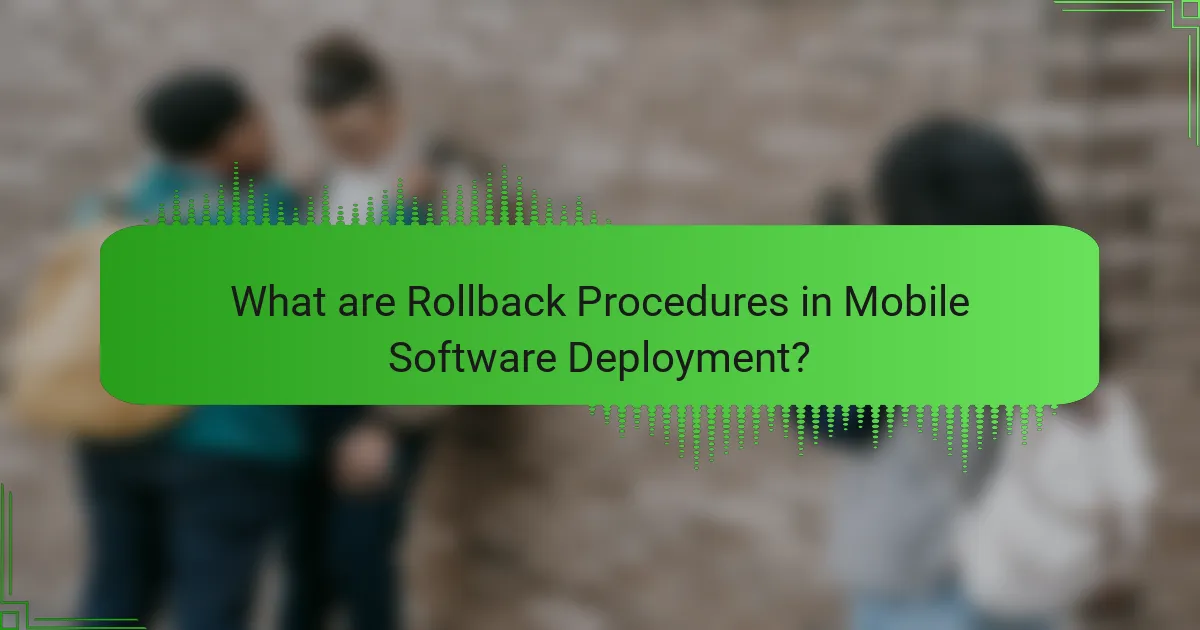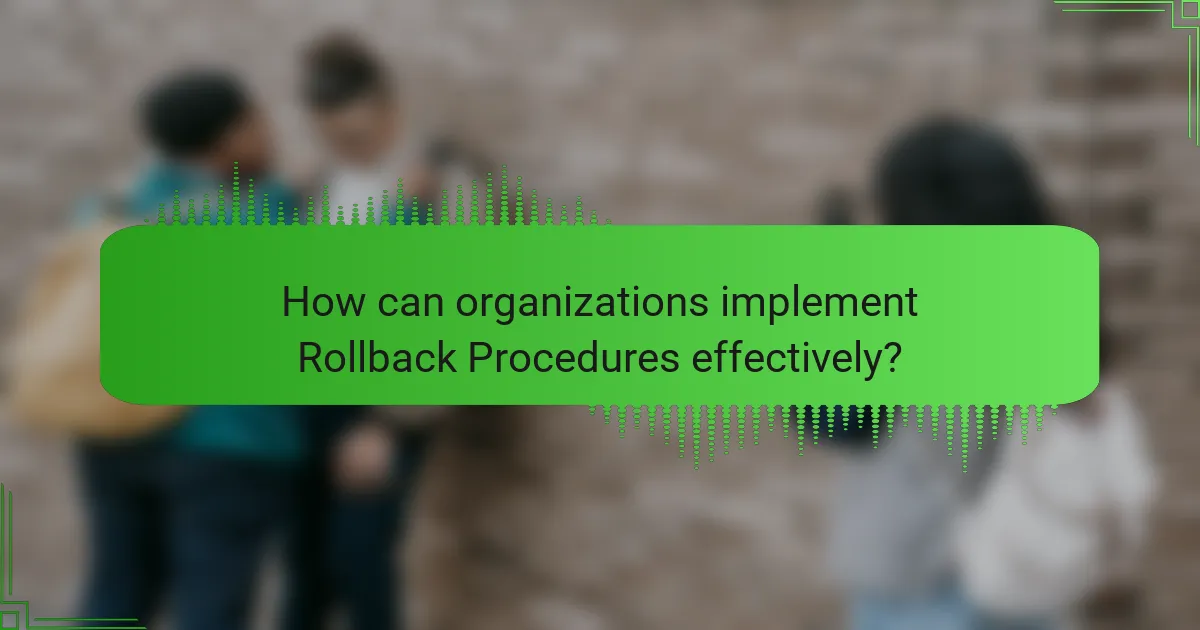Rollback procedures in mobile software deployment are critical processes that enable organizations to revert applications to previous stable versions when new updates introduce bugs or performance issues. These procedures involve backing up the current version prior to deployment, ensuring that a quick recovery can occur with minimal user disruption. Effective rollback strategies can significantly reduce downtime, with research indicating reductions of up to 30%. The article outlines best practices for implementing rollback procedures, including the establishment of clear plans, stakeholder communication, regular training, and the use of automated tools, all aimed at enhancing the reliability and efficiency of the rollback process.

What are Rollback Procedures in Mobile Software Deployment?
Rollback procedures in mobile software deployment are processes designed to revert an application to a previous stable version. These procedures are essential for mitigating issues caused by new updates. When a deployment introduces bugs or performance issues, rollback procedures allow for quick recovery. They typically involve backing up the current version before deployment. If problems arise, the backup can be restored efficiently. This minimizes user disruption and maintains application reliability. Research indicates that effective rollback strategies can reduce downtime by up to 30%. Implementing automated rollback mechanisms further enhances deployment safety.
Why are Rollback Procedures important in Mobile Software Deployment?
Rollback procedures are crucial in mobile software deployment to ensure system stability. They allow developers to revert to a previous version if the new release causes issues. This minimizes downtime and user disruption. A study by Google indicated that 70% of mobile app failures stem from deployment errors. Quick rollback procedures can significantly reduce the impact of such errors. They also enhance user trust by ensuring a reliable experience. In addition, effective rollback strategies can streamline the update process, making future deployments smoother. Overall, rollback procedures are essential for maintaining app performance and user satisfaction.
What risks do Rollback Procedures mitigate?
Rollback procedures mitigate risks such as data loss, system instability, and user dissatisfaction. They ensure that if a deployment fails, the system can revert to a previous stable version. This minimizes potential downtime and service interruptions. Rollback procedures also protect against the introduction of new bugs or security vulnerabilities. Historical data shows that effective rollback strategies can reduce recovery time significantly. For instance, companies that implement robust rollback plans report up to 50% faster recovery from deployment failures. Thus, rollback procedures are essential for maintaining software reliability and user trust during updates.
How do Rollback Procedures enhance user experience?
Rollback procedures enhance user experience by providing a safety net during software updates. They allow users to revert to a previous version if issues arise. This capability reduces downtime and frustration for users. Users can maintain functionality while problems are resolved. According to a study by the Software Engineering Institute, rollback procedures can decrease user-reported issues by up to 30%. This statistic underscores the effectiveness of rollback procedures in preserving user satisfaction. Additionally, seamless rollbacks build trust in software reliability. Users feel more secure knowing they can recover from unexpected errors quickly.
What are the key components of effective Rollback Procedures?
The key components of effective Rollback Procedures include clear documentation, automated processes, and testing protocols. Clear documentation outlines the steps to revert changes and identifies the conditions for rollback. Automated processes ensure quick execution of rollback actions, minimizing downtime. Testing protocols validate the rollback procedures to confirm they function correctly before deployment. These components collectively enhance the reliability and efficiency of rollback procedures in mobile software deployment.
What tools are commonly used in Rollback Procedures?
Common tools used in rollback procedures include version control systems, backup solutions, and deployment automation tools. Version control systems, such as Git, allow developers to track changes and revert to previous versions easily. Backup solutions, like Acronis or Veeam, ensure data is securely stored and can be restored if needed. Deployment automation tools, such as Jenkins or Octopus Deploy, facilitate the rollback process by automating the reversion to stable versions. These tools enhance reliability and minimize downtime during software deployment.
How do different platforms affect Rollback Procedures?
Different platforms significantly influence rollback procedures due to their unique architectures and capabilities. Each platform, such as iOS or Android, has distinct methods for managing application states. iOS utilizes versioning through App Store updates, allowing for straightforward rollbacks. Android, on the other hand, supports multiple versions on devices, complicating rollback processes.
Additionally, the underlying file systems differ, affecting how data is stored and retrieved during rollbacks. For example, iOS employs a sandboxing model, isolating app data and making rollbacks simpler. In contrast, Android’s more open environment may lead to data conflicts during rollback attempts.
Furthermore, platform-specific tools and frameworks impact the efficiency of rollback procedures. iOS developers can leverage Xcode’s built-in version control, while Android developers might rely on Gradle scripts for managing dependencies. These tools dictate the ease with which developers can revert to previous application states.
Overall, the interaction between platform characteristics and rollback methodologies determines the effectiveness and complexity of rollback procedures in mobile software deployment.

How can organizations implement Rollback Procedures effectively?
Organizations can implement rollback procedures effectively by establishing a clear plan and process. This includes defining the criteria for when a rollback is necessary. Organizations should ensure that all stakeholders understand their roles in the rollback process. Regular training and drills can help prepare teams for execution. It is essential to maintain up-to-date backups of all relevant data and software versions. Automated tools can facilitate quick and efficient rollbacks. Additionally, organizations should document each rollback event to improve future procedures. Research indicates that structured rollback processes reduce downtime by up to 30%.
What steps should be taken to prepare for Rollback Procedures?
Identify the critical components of the software deployment process. Assess the current state of the software and its dependencies. Document the existing configurations and settings. Create a backup of the current system before deployment. Establish a clear rollback plan that outlines the steps to revert changes. Test the rollback procedures in a controlled environment to ensure effectiveness. Communicate the rollback procedures to all team members involved. Regularly review and update the rollback plan based on new deployments or changes in the system.
How can teams assess the need for a rollback?
Teams can assess the need for a rollback by evaluating system performance and user feedback. Monitoring key performance indicators (KPIs) helps identify issues. If KPIs show significant degradation, a rollback may be warranted. User feedback through reviews or support tickets can indicate dissatisfaction. Analyzing error rates and crash reports provides additional insights. If critical bugs are detected, immediate action may be necessary. A rollback decision should consider the severity and impact of the issues. Historical data from previous deployments can also inform the assessment process.
What role does testing play in Rollback Procedures?
Testing is crucial in rollback procedures as it ensures the reliability of the rollback process. It identifies potential issues before deployment. Effective testing verifies that the previous stable version can be restored without errors. It also assesses the integrity of data during the rollback. Furthermore, testing helps to confirm that the rollback does not introduce new problems. By simulating rollback scenarios, teams can prepare for real-world failures. This proactive approach minimizes downtime and user impact. Therefore, thorough testing is essential for successful rollback procedures in mobile software deployment.
What common challenges arise during Rollback Procedures?
Common challenges during rollback procedures include data loss, system downtime, and compatibility issues. Data loss can occur if not all user data is properly backed up before the rollback. System downtime is often inevitable, causing service interruptions for users. Compatibility issues may arise when reverting to a previous version that does not support newer hardware or software configurations. Additionally, incomplete rollbacks can lead to inconsistent system states. These challenges can hinder the effectiveness of rollback procedures in mobile software deployment.
How can organizations overcome these challenges?
Organizations can overcome challenges in rollback procedures by implementing clear protocols and automated systems. Establishing a comprehensive rollback strategy is essential. This includes defining specific criteria for when to initiate a rollback. Training staff on these protocols ensures everyone understands their roles. Utilizing automated tools can streamline the rollback process and reduce errors. Regular testing of rollback procedures helps identify potential issues before they arise. Monitoring system performance post-deployment allows for quick responses to problems. Research indicates that organizations with structured rollback plans experience fewer disruptions during software updates. This structured approach enhances overall deployment efficiency.
What are the consequences of poorly executed Rollback Procedures?
Poorly executed rollback procedures can lead to significant operational disruptions. These disruptions may include extended downtime for applications. Users can experience loss of access to critical functionalities. Data integrity issues may arise, resulting in corrupted or lost data. Additionally, customer trust can diminish due to service unreliability. Financial losses can occur from halted operations and decreased productivity. Compliance risks may increase if data management standards are not met. Lastly, the organization may face reputational damage in the market.

What best practices should be followed for Rollback Procedures?
Best practices for rollback procedures include having a well-defined rollback plan. This plan should outline specific steps to revert to a previous version of the software. It is essential to test the rollback procedure in a staging environment before deployment. Documenting the rollback process ensures clarity and consistency during execution. Regularly updating the rollback plan is crucial to accommodate changes in the software. Communication with stakeholders is necessary during the rollback process to manage expectations. Additionally, maintaining backups of current and previous versions aids in quick recovery. These practices enhance the reliability and effectiveness of rollback procedures in mobile software deployment.
How can teams ensure a smooth rollback process?
Teams can ensure a smooth rollback process by implementing a structured plan. This plan should include clear documentation of the deployment steps. Teams must maintain version control for all software releases. Regular backups of data and configurations are essential prior to deployment. Automated rollback scripts can expedite the process if issues arise. Testing the rollback procedure in a staging environment is crucial. Communication among team members during the rollback is necessary to coordinate efforts effectively. Monitoring tools should be in place to identify problems quickly. These strategies collectively minimize downtime and ensure a seamless transition back to the previous version.
What documentation is essential for Rollback Procedures?
Essential documentation for rollback procedures includes a rollback plan, change logs, and backup records. The rollback plan outlines the steps to revert to a previous version of the software. Change logs detail all modifications made during the deployment process. Backup records provide information on the state of the system prior to changes. These documents ensure a structured approach to rollback, minimizing downtime and data loss.
How can communication be optimized during Rollback Procedures?
Clear and timely communication can be optimized during rollback procedures by establishing predefined communication protocols. These protocols should include specific roles and responsibilities for team members. Regular updates should be communicated through designated channels, ensuring everyone is informed of the rollback status. Utilizing real-time collaboration tools can enhance transparency and facilitate immediate feedback. Documentation of the rollback process and decisions made should be shared with all stakeholders to maintain clarity. Conducting post-rollback reviews can identify communication gaps and areas for improvement. Studies show that effective communication reduces confusion and accelerates recovery times during software rollbacks.
What are the lessons learned from past Rollback Procedures?
Past Rollback Procedures reveal key lessons in mobile software deployment. Effective communication is essential during rollbacks to ensure all stakeholders are informed. Testing rollback processes before deployment minimizes risks of failure. Documentation of rollback procedures aids in faster recovery and reduces confusion. Analyzing past incidents helps identify common failure points for future improvements. User feedback is valuable for refining rollback strategies. Continuous monitoring post-rollback is crucial to ensure system stability. Finally, having a dedicated rollback team enhances efficiency and accountability during the process.
How can organizations leverage feedback for future Rollback Procedures?
Organizations can leverage feedback for future rollback procedures by systematically analyzing user input and performance data. This approach helps identify common issues and areas for improvement. Feedback can be gathered through surveys, support tickets, and user analytics. By categorizing this feedback, organizations can pinpoint specific failure points in the deployment process.
For example, a survey may reveal that users frequently encounter bugs after updates. Addressing these bugs in future updates can enhance stability. Additionally, performance data can highlight patterns that lead to rollbacks, such as spikes in error rates.
Implementing a feedback loop allows organizations to adjust their rollback strategies based on real-world experiences. This iterative process can lead to more effective and reliable software deployments. Ultimately, leveraging feedback creates a proactive approach to managing software updates and rollbacks.
What practical tips can enhance Rollback Procedures in Mobile Software Deployment?
Implementing automated rollback processes enhances rollback procedures in mobile software deployment. Automation reduces human error and speeds up recovery times. Regularly testing rollback procedures ensures they function correctly under various scenarios. Maintaining detailed logs of deployment actions aids in identifying issues quickly. Utilizing version control systems allows for easy tracking of changes and quick reversion to stable versions. Clear communication channels among team members facilitate faster decision-making during rollbacks. Establishing a rollback plan before deployment minimizes chaos in case of failure. Regular training for team members on rollback procedures ensures preparedness and efficiency.
Strategies for Rollback Procedures in Mobile Software Deployment focus on the essential processes that allow developers to revert applications to stable versions after problematic updates. The article outlines the importance of rollback procedures in maintaining system stability, minimizing downtime, and enhancing user trust. Key components such as clear documentation, automated processes, and effective testing protocols are discussed, along with common tools and challenges faced during rollbacks. Additionally, the article emphasizes best practices and the significance of leveraging feedback for continuous improvement in rollback strategies.


